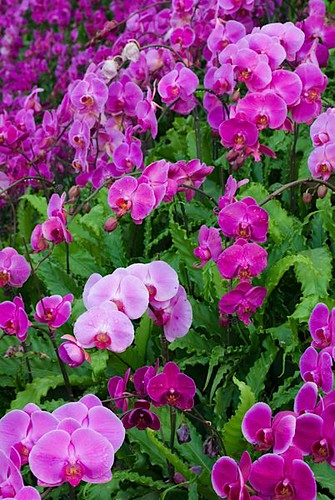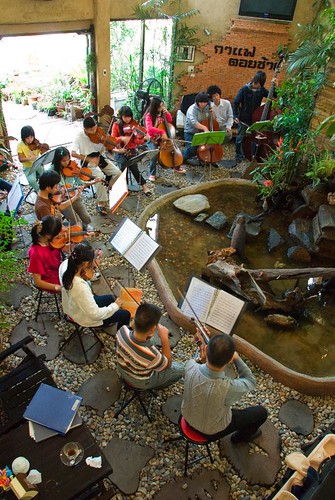Chiang Rai is a fairly unprepossessing town in northeast Thailand. Most tourists who visit are there for a day or two while passing through to Laos, and may visit some of the historic wats, take a trip or two out of town to somewhere like the White Temple, and visit the Night Bazaar in the evening. Few people spend a week or more. This is a shame because Chiang Rai is a very friendly town and a pretty good place to explore normal northern Thai life away from the main sights and activities. If you do want to spend more time here are some ideas for things to do, places to see, from longtail boat trips and walking market shopping expeditions to coffee and classical music. This complements my reviews of Chiang Rai wats and the Night Bazaar.
There is a TAT Tourist Office in town. It has free maps and some useful info on places to go too. There is also a quarterly free English-language Chiang Rai magazine with some ideas for places to visit in and outside town as well as useful maps.
Take a Longtail boat
With the dusky Mae Kok river running through Chiang Rai, it is a good point to take a trip or tour on a longtail boat to see the forested hills sweep by. They can be chartered from the pier near to the bridge past the Bamboo Wat. Prices depend on distance and bargaining charm. You can go upstream to Ban Ruamit Elephant camp, My Dream at Khaew Waaw Dam village and Tha Ton or downstream as far as Chiang Mai.
Sniff the flowers

Orchids in 2009
Chiang Rai hosts a colourful flower show every January on the enthusiastically named Chiang Rai beach. Its worth going for the extensive displays of orchids alone. You can catch one of the many longtails ferrying passengers between the pier and the beach for about 20B a person one way.
Tell the time

Clock tower counting down to new year 2009
The artist who designed the White Temple also donated a new clocktower to Chiang Rai. He felt the old one was a bit shoddy and that Chiang Rai needed a new tourist sight. It is a gold tower in his flamboyant neo-Thai style. Not only does it tell the time but it also displays its own mini light-show on the hour at 6pm, 7pm and 8pm. It is near to the local produce market, to where the old clock has been relocated, at the junction of thanons Suksathit, Phahonyothin, Jet Yot and Banphrakan.
Drink tea, do coffee

Panja Bakeshop
Chiang Rai has lots of great little, independent café-cum-bakeries dotted throughout town. Each serves Chinese and black teas, coffee and home-baked cakes. There are plenty to choose from by strolling around town. Here are three of my favourites. Panja Bakeshop is a very friendly Thai-Chinese café on Th Suksathit between the produce market and the clocktower. It is great for small Chinese-style savoury or sweet pastries. You can also say hello to Elvis the fish. BaanChivitMai is a Swedish-run place near to the old bus station in the centre of town. It has delicious cakes and a vast range of 5B cookies as well as internet. All profits go to local charity work. Doi Chaang is the café of one of the local premium coffee estates. An air-con ground floor room and a first floor balcony surround two side of an atrium full of plants cascading around a naturalistic fountain. It is just north of the Night Bazaar on Th Ratanaket.
Listen to classical music

Orchestral manoeuvres in Doi Chaang
Doi Chaang hosts free chamber concerts by the Chiang Rai Youth Orchestra. They are currently weekly on Sunday afternoons. The atrium fills with young violinists, cellists and a worker of the double bass playing a range of light classical classics. The orchestra leader is a very dedicated music teacher.
Read a book
There are two secondhand bookshops in town where you can buy and part-exchange paperbacks. Gare Garon is near the bus station, while the cheaper Orn’s Bookshop is just past Wat Jet Yot. Orn’s is the eponymous shop of a very friendly German ex-pat.
Walk to the shops

Walking Market food market
Every Saturday night Th Thanalai is closed to traffic and converted into the Walking Market, a very long market boasting plenty of stalls selling local handicrafts, clothes and food. One adjoining square is given-over to a large food market with stalls selling a range of meals and snacks. Music and dance performances are scattered along its length. The market competes well with the Chiang Rai Sunday Walking Market for atmosphere and range of stalls, while surpassing its more famous twin on food. It begins about 4pm and gets pretty crowded by 8pm, before closing about 10pm. It is a great place to browse and buy gifts, eat some great food and join in with Thais doing one of their favourite leisure activities – shopping combined with eating.
Do lunch

Rimkok pool
Most of the upmarket resorts in and around town put on sumptuous and extensive buffet lunches. You can enjoy a vast range of Thai and Western meals, salads, fruit and desserts for about 150 baht a person. The Rimkok, just outside of town on the otherwise of the river, has a particularly good one for 140 baht. It is served in the restaurant near the pool. If you’re vegetarian simply ask them to cook you some veggie meals when you buy your ticket and they’ll being them to your table shortly after you sit down. We were served four different veggie Thai dishes. The Rimkok also has the only pool open to non-guests. You can enjoy the long, curving pool with outdoor jacuzzi for the day at 80 baht a person. Go five times and your sixth visit is free.
Discover where old spirit houses go to die

Spirit Houses under the Big Tree
There is a beautifully big tree near the public library. Turn left off the main road at the tourist office and go down the quieter road, take a right turn, left and another right on the same road and you'll see the spreading canopy of the tree span the road. People deposit old spirit houses under this auspicious tree.


















